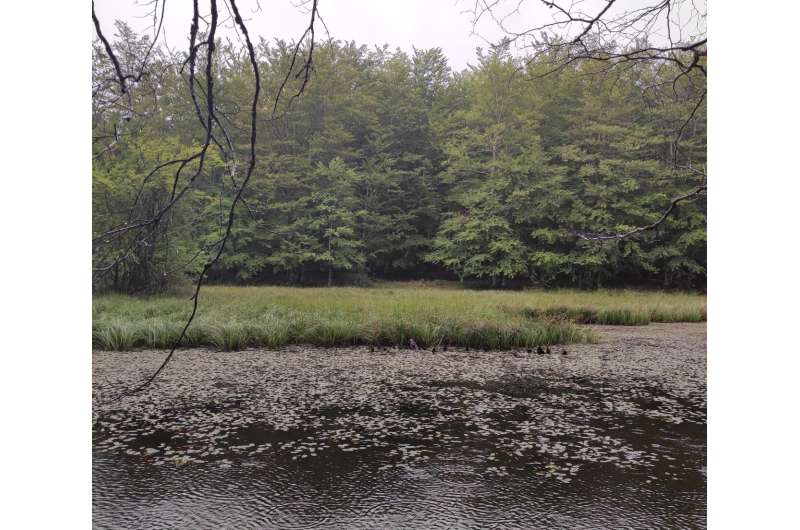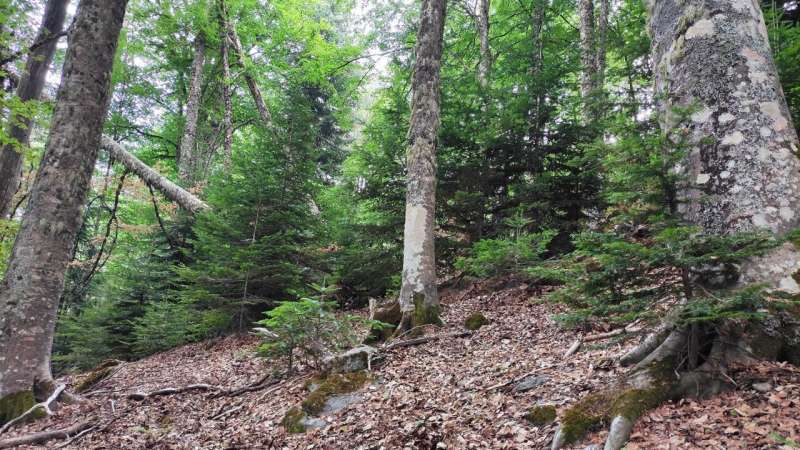Landscape ecological history supports rewilding for biodiversity conservation and climate mitigation in Mediterranean

A multidisciplinary historical ecology research carried out in Pollino National Park (southern Italy) reveals that rewilding processes triggered by abandonment or changes in land-use priorities have contributed to the conservation and local expansion of the relic mixed beech-fir forest during the last thousand years.
Rewilding was identified as a key strategy to restore old-growth mixed forest stands, which structural and compositional complexity generates countless ecosystem services since the late Medieval. In contemporary times, industrialization and urbanization have depopulated rural environments and a new spontaneous rewilding process has started. Letting nature have space without any other interference is a zero-input solution for biodiversity conservation and climate mitigation.
Many places around the world have been impacted by human activities since ancient times. This is especially the case of Mediterranean countries, where local traditions and land-use practices have shaped cultural landscapes. However, times change, and practices once extensively carried out in rural areas sometimes give way to other forms of land-use and natural resources management.
In the last decades, urbanization—i.e., the movement of population to urban centers—has caused the depopulation of Mediterranean rural areas and the abandonment of traditional land-use, triggering an ecological process called rewilding.
The rewilding of abandoned mountain pasturelands and agricultural fields is contributing to expansion of forests and carbon sequestration in wood and soils. While on one hand rewilding means loss in traditions and management practices, on the other hand it can led to natural restoration of functional ecosystems and species vulnerable to human impacts.
It is not simple to direct landscape planning policies and stakeholders' viewpoints towards concrete objectives without scientific baselines supporting rules and planning decisions. At the same time, it is not simple to gather scientific evidence able to predict long-term ecological processes. A solution could be the study of the past.
This is what a group of researchers from the University of Tuscia (Viterbo, Italy) and University of Nevada, Reno (U.S.) wanted to address by describing the ecological history of a mountain forest within today's Pollino National Park (southern Italy). Those lands were historically characterized by alternating periods of intensive land exploitation and abandonment during the last thousand years, as documented by historical sources.
The study, recently published in the journal Ecological Applications describes the evolution of the mountain forest since the 9th century CE, when the environment was almost completely devoid of forest. Historical sources were crucial to understand the role past land-use practices, sociopolitical changes and climatic shifts have played in the evolution of the local forest, which is today protected by the National Park and the Natura 2000 Network.

"The historical ecology of this site was particularly interesting because it hosts one of the few relic mixed forests of European beech and silver fir that remained in the Apennines," says Gianluca Piovesan, professor in Ecological Landscape Planning at the University of Tuscia, co-author of the study.
These vulnerable forest ecosystems have undergone a dramatic decrease throughout Europe when anthropogenic pressures like frequent fires, coppicing and grazing became widespread in Mediterranean forests. "We were particularly interested in understanding how the relic mixed forest survived and changed over time, so that we could direct management decisions towards effective restoration strategies," added the professor.
Results were surprising. The open landscape described by the local pollen assemblage was quickly colonized by silver fir in a time when changes in the sociopolitical structure reduced human pressures on mountain lands. It also coincides with a cool-wet climatic phase that likely helped the silver fir stand to settle and dominate the landscape for almost three centuries. It happened during Norman domination in southern Italy, and the scientists suppose a possible role of Normans' forest management rules in supporting the silver fir stand over other forest species.
The expansion of the silver fir stand following the abandonment of management practices was seen also in contemporary times. During the 18th century, the increased pressure on forest resources have caused a decline in the local forest cover and silver fir abundance, leading to the expansion of European beech which today dominates the mountain belt in most of the Apennine mountain chain.
Part of the study area was designed as State Forest in the early '900s and the use of forest resources was regulated following national rules since that time. Few decades later, in the '70s the State Forest became a Natural Reserve and lastly in the '90s the area was incorporated into the National Park. Results highlight that the protection ensured during the last century has arrested the declining trend of the silver fir stand and, in the last decades, has contributed to a new pulse of regeneration despite warming temperatures.
In this study, researchers have performed a quantitative reconstruction of forest cover using pollen accumulation rates, a proxy of tree density and wooden biomass. "Although forest compositional features are now moving towards those seen in the past, we are still pretty far from the potentiality of this forest in terms of structural complexity and biomass," says Jordan Palli, Ph.D. student and pollen analyst at the University of Tuscia.
The highest accumulation values were reached between the 14th and the 17th centuries, following severe plague outbreaks (Black Death) that decimated the local population. "We suppose that the complete cessation of management and resource use due to the Black Death outbreak let local forest gain its highest structural and compositional complexity," added the Ph.D. student from the University of Tuscia, lead author of the study.
"Today, we are assisting to the same ecological process in rural areas—i.e., management cessation and/or abandonment. In our opinion, it represents an opportunity to leave the mountain environment to its natural dynamics and restore a number of functional natural ecosystems and associated services without any further energetic input."
Many issues related to the complex relationship between humans and nature can be better solved by looking at the past. Complex landscapes consisting of natural and cultural heritages such as those in Mediterranean have already experienced several pressures, both anthropogenic, climatic and the combination of the two. Understanding how ecosystems have responded is the key that unlocks effective sustainable long-term planning results.
More information: Jordan Palli et al, Historical ecology identifies long‐term rewilding strategy for conserving Mediterranean mountain forests in south Italy, Ecological Applications (2022). DOI: 10.1002/eap.2758
Journal information: Ecological Applications
Provided by University of Tuscia




















